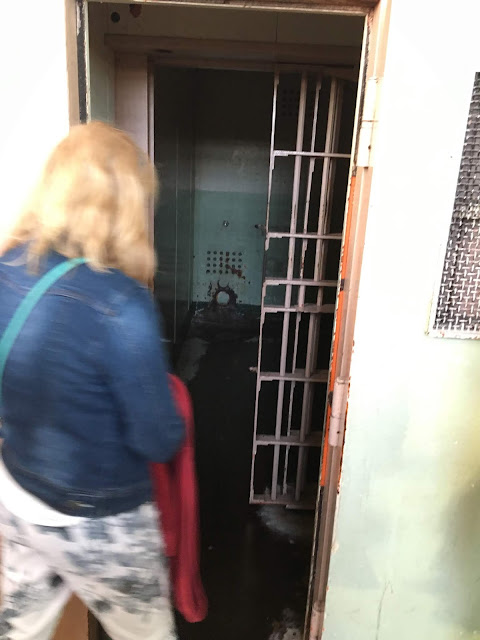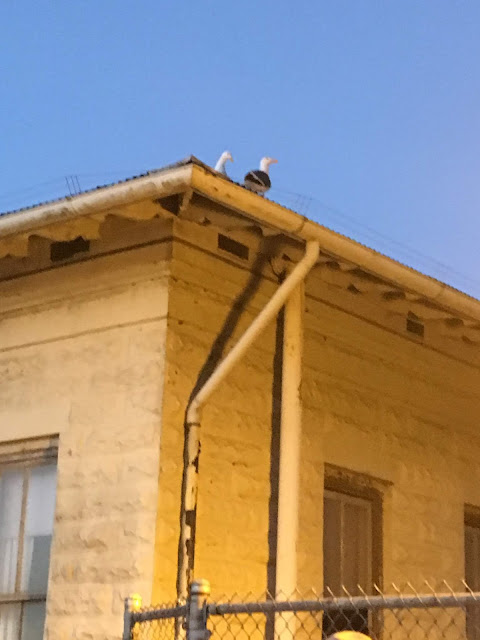My first view of "The Rock" from the ferry boat. You can easily see Alcatraz as you pass over the Golden Gate, but to see it up close like this is something else.
You can see the white cliffs, which show just how difficult it would be to escape. I mean where would you go? It's a long swim across the bay (our guide said there aren't really Great White sharks in the bay, which is something I've heard before) in frigid waters at the best of times.
And the cliffs aren't really white. Since it closed down, the island has become a bird sanctuary. The cliffs are white from all the bird shit.
As soon as we got off the ferry our ranger (Alcatraz is now a National Park), led us up what amounted to a fiver story climb to the actual prison. He periodically stopped to answer questions and explain more about the prison.
One question he asked right away was, "You've just been sentenced to 25 years in Alcatraz. What is your biggest fear?" The people quickly called out the obvious: rape, isolation, loneliness, death . . .
But the ranger said that the most common fear, oddly enough, was this: what will I do after Alcatraz?
The fear of fitting back in (or being accepted back into society) was a real fear.
I never even thought of that!
The tour of Alcatraz was really cool. It involved a worker handing each of us what amounted to an iPod and a set of headphones. The iPod contained an automated guided tour narrated by former prisoners and guards.
An inmate or guard would say, "Now you've entered Alcatraz. Straight ahead is the hallway the prisoners dubbed Broadway. Walk toward Broadway. Then turn right. Continue down the hall until you see cell number 155 on your right . . ."
It was fascinating. You could pause it when you wanted to look closer or take pictures.
I was so engaged by the whole thing that I was well on my way through the tour before I realized I hadn't been taking any pictures! And I call myself a wanna be millennial!!!
Here is what you see as you are about to be issued your prison garb.
The towering cells.
This would be your home for 23 hours a day at "The Rock."
Another cell.
The former prisoners who narrated the tour.
There were quite a few people packed in the cell block for the tour.
I believe this was the solitary confinement area. On the way up to the prison, I asked the ranger what the record for solitary confinement was. He said one prisoner spent 14 years here! However, this side of the prison did come with a perk. It was on the east side, facing San Francisco. So you could catch the sun as it rose. Prisoners also enjoyed listening on New Year's Eve, for voices from people on yachts would carry across the bay to them and give them hope.
A student peers into a solitary confinement cell. Could you imagine spending 14 years inside?
This was the size of the hole the most famous escapees used to get out of their cells. The removed the plate and chipped away at the walls to get out.
The visitors station. One prisoner noted how amazed he was when a guard notified him that someone was there to see him. He couldn't believe it. It was his sister. In front of him was a beautiful woman. The last time he saw her she was just a child.
The uniform that all guards wore.
The guard tower. If you made a run for it, this is from where the guards shot you. Worse than that, possibly, was what you can see beyond the base of the tower: the city of San Fran. One of the prisoners noted how devilish this was on behalf of those who designed "The Rock." Whenever prisoners glanced up, they would be constantly reminded of what they were no longer permitted to be a part of. If you could just imagine being a prisoner for 25 years and seeing the city grow and change over that time period. All the while harkening back to your biggest fear about not being able to fit in. You can see the city grow and change and realize it moves too fast for you because everything around you for the past 25 years has stayed exactly the same.
This was frightening, but the guides never mentioned what it was. Just a bloody hand print above a doorway.
This is what the guards found when the searched the cells of the most famous escapees. Before they left, they created paper machete imitations to place in the bed so no one would know they were gone for several hours.
We ended touring the cafeteria. The guide noted how the federal government demanded that the food had to be good. And it was. Initially. However, like our school lunches, it soon went downhill. The prisoners were so tired of the same horrific spaghetti that they all tipped the tables over in protest.
The guard, who was also narrating the tour, said he was just one of three guards in the mess hall. When this happened he knew he was facing an all out riot. So he did the only thing he knew to do - he broke some window panes to get their attention and began firing three shots into the air.
He said that calmed them all down because he told them all calmly, "You all know where the next shots are going to land."
The guide then mentioned how the entire cafeteria had riot gas containers on the ceiling in case of riots. The only problem - signaling them to open meant that the three guards on duty in the cafeteria would surely die. Thus, they were never used.
As we left, we all noticed the lone inhabitants of the island watching us constantly.
The final ranger we met with who narrated all of the escape attempts at Alcatraz. He was amazing!




















No comments:
Post a Comment